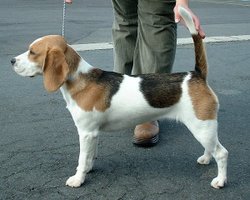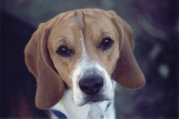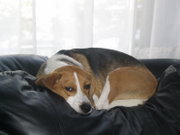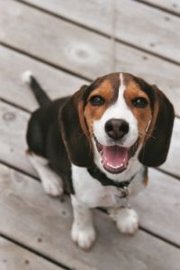
|
Dog breeds, Beagle |
| Beagle | ||
|---|---|---|

A tri-color Beagle.
|
||
| Alternative names | ||
| English Beagle | ||
| Country of origin | ||
| United Kingdom | ||
| Common nicknames | ||
| Classification and breed standards | ||
| FCI: | Group 6 Section 1 #161 | |
| AKC: | Hound | |
| ANKC: | Group 4 (Hounds) | |
| CKC: | Group 2 - Hounds | |
| KC (UK): | Hound | |
| NZKC: | Hounds | |
| UKC: | Scenthound Breeds | |
| Not recognized by any major kennel club | ||
| This breed of Dog is extinct | ||
| Notes | ||
A Beagle is a medium-sized Dog breed and a member of the hound group, similar in appearance to a Foxhound but smaller with shorter legs, and with longer, softer ears. Beagles are scent hounds used primarily for hunting rabbits to larger hares.
The Beagle has a somewhat oval skull; a medium-length, square-cut muzzle; large, hound-like hazel or brown eyes; long, low-set ears (big), turning towards the cheeks slightly and rounded at the tips; a medium-length, strong neck without folds in the skin; a broad chest narrowing to a tapered abdomen and waist; a short, slightly curved tail; an overall muscular body; and a medium-length, smooth, hard coat. One standard calls for ideally shaped beagles to be twice as long as tall, and twice as tall as wide.
They appear in a range of colors, not limited to the familiar tricolor (white with large black and light brown spots). Two-color varieties are always white with colored areas, including such colors as "lemon", a very light tan; "red", a reddish, almost orangish brown; "liver", a darker brown, is the only colour not allowed. "Ticked" varieties may be either white or black with different colored spots ("ticking"), such as the bluetick beagle, which has spots that appear to be a midnight-blue color, similar to the bluetick coonhound. Some tricolor beagles also have ticking of various colors in their white areas. The brown is usually the last color to appear on beagles, usually taking 1-2 years to fully develop. Beagles have a white-tipped tail, or "flag", which is important in locating them in the field due to their short height.
The American Kennel Club and the Canadian Kennel Club recognize two separate varieties of Beagle: the 13-inch for hounds less than 13 inches, and the 15-inch for those between 13 and 15 inches. The Kennel Club (UK) and FCI affiliated clubs recognize a single type, with a height of between 13 and 16 inches.
In Medieval times, there was a breed called a "pocket beagle", which stood at 8?9 inches. This breed no longer exists, and many claims by some breeders to have pocket beagles for sale usually indicate poor breeding practices.
 The Beagle has a very well-developed sense of smell
The Beagle has a very well-developed sense of smell
The Beagle has a very good temper and gentle disposition. Beagles are intelligent, but are stubborn and may be hard to train (due to their strong will). They are an especially loyal breed and are very friendly. They rarely show signs of aggression, and are excellent with children. Beagles also get along with other Dogs, provided that they have been socialized correctly.
They are playful and energetic Dogs who enjoy long walks. Never let a Beagle off its leash except in a confined area. If released, it may follow a scent endlessly or will incessantly try to tag along with other Dogs.
Beagles are pack animals, and can be prone to separation anxiety. Beagles are best in pairs if they are going to be alone for long periods of time.
Beagles are a healthy breed, often living for 12 to 15 years, but they do have a few common health problems.
The Beagle's ears are long and floppy, which can trap warm moist air or prevent air from reaching the ear canals. This condition can be successfully treated with regular cleaning daily and sometimes medication for major cases. Careless bathing can get water into their ears, potentially causing ear infections.
Sometimes their eyelashes grow into the eye and irritate the eye; this might require surgery to remove the eyelashes.
Obesity is a common health problem in Beagles due to people overfeeding them in response to their playful and kind behavior. A healthy Beagle should have some definition to its waist and have an hourglass appearance when viewed from above. You should be able to feel their ribs. Excessive weight can lead to problems such as hip dysplasia and heart trouble. They need exercise and a good diet.
Some Beagles are prone to congenital heart disease.
In some rare cases Beagles may develop polyarthritis (where the immune system attacks the joints) even at a young age. This can be sometimes treated effectively with cortisone.
Beagles are also prone to seizures/epilepsy. This disease is treatable with medication.
 The rare instance of a Beagle taking a break.
The rare instance of a Beagle taking a break.
Beagles (or their ancestors) appear to have been used for hare hunting in England as early as the reign of Edward III, who had a pack of up to 120 hare hounds with him on the battlefield during the Hundred Years' War. The first mention of the beagle in English literature by name dates from 1475. The origin of the word "beagle" is uncertain, although it has been suggested that the word derives from the French begueule (meaning "open throat", or more colloquially, "loudmouth") or from an Old English, French, or Welsh term beag, meaning "small." Other possibilities include the French beugler (meaning "to bellow") and the German begele (meaning "to scold").
Beagles were originally used for hunting, and still are in some places. Beagling has been referred to as "the poor person's foxhunting," as a Beagle pack (30?40 Dogs) is followed on foot, not horseback. The usual quarry is the hare. Beagles are admired by some for the bloodcurdling "Beagle music" they emit when in full pursuit, also called tonguing. Beagling, like foxhunting, is banned in England. Drag hunting is another Beagle sport.
 A Very Happy Beagle Puppy
A Very Happy Beagle Puppy
Beagles have superb noses and, despite their self-willed temperament, are sometimes used as sniffer Dogs for drug detection. More often, though, they are the breed of choice of the United States Department of Agriculture to detect food items in luggage being transported into the U.S. The force is called the Beagle Brigade and these Dogs wear a green jacket. Beagles were chosen because they are small and easy to care for, and because they are not as intimidating for people who are uncomfortable around Dogs. They are also used for this purpose by the Ministry of Agriculture and Fisheries in New Zealand and by the Australian Quarantine and Inspection Service (for whom they wear maroon jackets).
Beagles are the Dog breed most often used in animal testing, due to ther passive nature.
Dog breeds of the world, Beagle